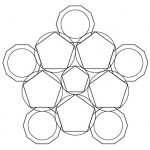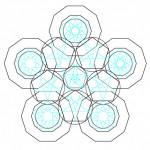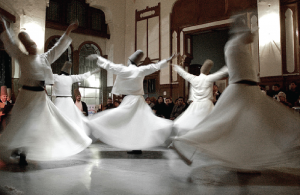ABJAD Designs Store Coded Messages
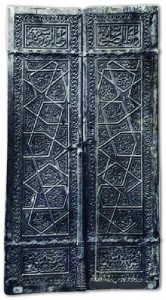 I have been working on my latest book, “The Arabs,” – a new title in the “Geometry Through Time,” series. I’d like to share an idea originally formed in the 1960’s, and that I have been further developing for “The Arabs”; that of the possible use of the ABJAD system to store coded messages in Islamic geometric designs.
I have been working on my latest book, “The Arabs,” – a new title in the “Geometry Through Time,” series. I’d like to share an idea originally formed in the 1960’s, and that I have been further developing for “The Arabs”; that of the possible use of the ABJAD system to store coded messages in Islamic geometric designs.
Arabic script is primarily consonantal in form, the vowels were added later and appear as the many wavy lines and dots you see above and below the consonants. The ABJAD system provides a numeric value to each consonant, so a three consonant word, for example, can have three numbers assigned to it – one for each letter. The ABJAD system also provides a means by which numbers can be manipulated, so that the numbers corresponding to a word can be transformed to correspond to more than one word. For example, numbers can be re-arranged, or replaced by multiples of ten. The numbers, ten, five, and six, can be re-arranged as five, six, and ten, or transformed to become, sixty, fifty, and ten.
It appears that certain Islamic designs were ABJAD encoded to communicate simple messages, give instructions, or convey ideas. It does seem that many designs were encoded deliberately, and not accidentally, with meanings supported by the environment in which the designs appear. In the Alhambra, for example, many designs consist of symmetric repeats of two and three sided rosettes that can be translated into messages of love; meanings that make sense as the Alhambra was somewhat of a “pleasure palace.” I have a prayer rug that, when numbers are counted and translated into consonants, appears to give instructions with regard to positioning hands, head, and body, to pray, whilst conjuring images for a person to reflect upon.
To explore the idea that ABJAD messages are encoded in Islamic designs you need two things. The first is an old arabic root dictionary; preferably published in the eighteen hundreds or early nineteen hundreds. The second is that you will need to understand the geometrical system in the architectural structure, or art and design form, that you are looking at.
An example of a possible ABJAD encoded design appears on a thirteenth or fourteenth century door to a Tekke (Tehk-keh) in Turkey. See the photograph above.
To understand the system used for the design firstly view the door panels as though they are touching each other. The complicated bit is to understand the design system itself, and this takes a knowledge of geometry and some analysis. In the case of the door, the design is based on close packing circles – where the close packing is limited to the area shown in the first line drawing. The master craftsmen then drew in the core numbers in terms of five and ten sided polygons. After that there is more complex development of five and ten sided rosettes drawn within the five and ten sided polygons. The above, three, line drawings show the first steps of the construction. There were, apparently, a number of primary design systems used to embed messages and then a methodology for applying them. To save yourself the work of exploring this idea you can buy my book, as soon as it is published!! From that point you should be able to start to to test the validity of the idea and discover for yourselves if Islamic rugs, walls, spaces, doors, art forms, etc., contain stored messages and ideas. My guess is, assuming the idea to be valid, that encoded designs started to appear from about the tenth century of the Christian era, but it’s possible that the tradition, if a tradition, started well before that. I do know that numbers were used to communicate messages long before ABJAD design applications; in knots tied in ropes, for example. If you have Islamic designs that you’d like me to analyze then please let me see them – or if you have evidence that supports the idea of ABJAD encoded designs, or undermines it, then please let me know.
The door design ends up looking like the drawing on the left below.
Applying the ABJAD system to the design, based on the primary numbers in the design, 5 and 10, and using an old arabic root dictionary we arrive at the following translations: 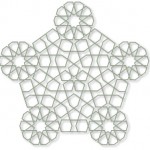
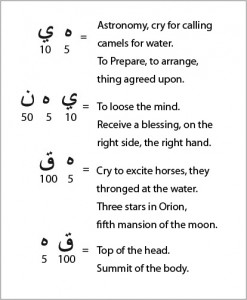
A Tekke is a hall or monastery known for the dances of the Whirling Dervishes. The Whirling Dervishes are known for a dance where they rotate in a circular fashion, with their right hands facing up and their left hands facing down. They wear tall hats, on top of their heads, and they whirl like stars in the night sky. They are called to dance, and gather together to do so, meeting as arranged. They are like thirsty travelers looking for water. It’s very possible that a symbolic dance arrangement, of the whirling dervishes, followed the positions of the close packing circles that form the foundation of the door’s design.
“The Arabs,” is not just another <geometry book> but, as with all the published and planned titles, in the “Geometry Through Time” series, contains new insights into the uses, and cultural applications, of geometrical systems used in the distant past through to new systems that may be used in the future.

